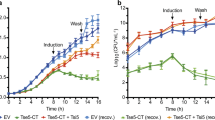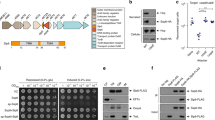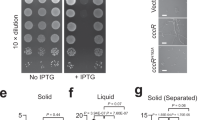Abstract
Peptidoglycan is the major structural constituent of the bacterial cell wall, forming a meshwork outside the cytoplasmic membrane that maintains cell shape and prevents lysis. In Gram-negative bacteria, peptidoglycan is located in the periplasm, where it is protected from exogenous lytic enzymes by the outer membrane. Here we show that the type VI secretion system of Pseudomonas aeruginosa breaches this barrier to deliver two effector proteins, Tse1 and Tse3, to the periplasm of recipient cells. In this compartment, the effectors hydrolyse peptidoglycan, thereby providing a fitness advantage for P. aeruginosa cells in competition with other bacteria. To protect itself from lysis by Tse1 and Tse3, P. aeruginosa uses specific periplasmically localized immunity proteins. The requirement for these immunity proteins depends on intercellular self-intoxication through an active type VI secretion system, indicating a mechanism for export whereby effectors do not access donor cell periplasm in transit.
This is a preview of subscription content, access via your institution
Access options
Subscribe to this journal
Receive 51 print issues and online access
$199.00 per year
only $3.90 per issue
Buy this article
- Purchase on Springer Link
- Instant access to full article PDF
Prices may be subject to local taxes which are calculated during checkout





Similar content being viewed by others
References
Hayes, C. S., Aoki, S. K. & Low, D. A. Bacterial contact-dependent delivery systems. Annu. Rev. Genet. 44, 71–90 (2010)
Hibbing, M. E., Fuqua, C., Parsek, M. R. & Peterson, S. B. Bacterial competition: surviving and thriving in the microbial jungle. Nature Rev. Microbiol. 8, 15–25 (2010)
Gründling, A. & Schneewind, O. Cross-linked peptidoglycan mediates lysostaphin binding to the cell wall envelope of Staphylococcus aureus . J. Bacteriol. 188, 2463–2472 (2006)
Vollmer, W., Pilsl, H., Hantke, K., Höltje, J. V. & Braun, V. Pesticin displays muramidase activity. J. Bacteriol. 179, 1580–1583 (1997)
Brötz, H., Bierbaum, G., Markus, A., Molitor, E. & Sahl, H. G. Mode of action of the lantibiotic mersacidin: inhibition of peptidoglycan biosynthesis via a novel mechanism? Antimicrob. Agents Chemother. 39, 714–719 (1995)
Riley, M. A. & Wertz, J. E. Bacteriocins: evolution, ecology, and application. Annu. Rev. Microbiol. 56, 117–137 (2002)
Hood, R. D. et al. A type VI secretion system of Pseudomonas aeruginosa targets a toxin to bacteria. Cell Host Microbe 7, 25–37 (2010)
Schwarz, S., Hood, R. D. & Mougous, J. D. What is type VI secretion doing in all those bugs? Trends Microbiol. 18, 531–537 (2010)
Cascales, E. The type VI secretion toolkit. EMBO Rep. 9, 735–741 (2008)
Boyer, F., Fichant, G., Berthod, J., Vandenbrouck, Y. & Attree, I. Dissecting the bacterial type VI secretion system by a genome wide in silico analysis: what can be learned from available microbial genomic resources? BMC Genomics 10, 104 (2009)
Ballister, E. R., Lai, A. H., Zuckermann, R. N., Cheng, Y. & Mougous, J. D. In vitro self-assembly of tailorable nanotubes from a simple protein building block. Proc. Natl Acad. Sci. USA 105, 3733–3738 (2008)
Leiman, P. G. et al. Type VI secretion apparatus and phage tail-associated protein complexes share a common evolutionary origin. Proc. Natl Acad. Sci. USA 106, 4154–4159 (2009)
Mougous, J. D. et al. A virulence locus of Pseudomonas aeruginosa encodes a protein secretion apparatus. Science 312, 1526–1530 (2006)
Kanamaru, S. Structural similarity of tailed phages and pathogenic bacterial secretion systems. Proc. Natl Acad. Sci. USA 106, 4067–4068 (2009)
Christie, P. J., Atmakuri, K., Krishnamoorthy, V., Jakubowski, S. & Cascales, E. Biogenesis, architecture, and function of bacterial type IV secretion systems. Annu. Rev. Microbiol. 59, 451–485 (2005)
Kelley, L. A. & Sternberg, M. J. Protein structure prediction on the Web: a case study using the Phyre server. Nature Protocols 4, 363–371 (2009)
Anantharaman, V. & Aravind, L. Evolutionary history, structural features and biochemical diversity of the NlpC/P60 superfamily of enzymes. Genome Biol. 4, R11 (2003)
Scheurwater, E., Reid, C. W. & Clarke, A. J. Lytic transglycosylases: bacterial space-making autolysins. Int. J. Biochem. Cell Biol. 40, 586–591 (2008)
Vollmer, W., Joris, B., Charlier, P. & Foster, S. Bacterial peptidoglycan (murein) hydrolases. FEMS Microbiol. Rev. 32, 259–286 (2008)
Gerdes, K., Christensen, S. K. & Lobner-Olesen, A. Prokaryotic toxin-antitoxin stress response loci. Nature Rev. Microbiol. 3, 371–382 (2005)
Hall-Stoodley, L., Costerton, J. W. & Stoodley, P. Bacterial biofilms: from the natural environment to infectious diseases. Nature Rev. Microbiol. 2, 95–108 (2004)
Schwarz, S. et al. Burkholderia type VI secretion systems have distinct roles in eukaryotic and bacterial cell interactions. PLoS Pathog. 6, (2010)
Mortensen, J. E., Fisher, M. C. & LiPuma, J. J. Recovery of Pseudomonas cepacia and other Pseudomonas species from the environment. Infect. Control Hosp. Epidemiol. 16, 30–32 (1995)
Nelson, K. E. et al. Complete genome sequence and comparative analysis of the metabolically versatile Pseudomonas putida KT2440. Environ. Microbiol. 4, 799–808 (2002)
Pukatzki, S., Ma, A. T., Revel, A. T., Sturtevant, D. & Mekalanos, J. J. Type VI secretion system translocates a phage tail spike-like protein into target cells where it cross-links actin. Proc. Natl Acad. Sci. USA 104, 15508–15513 (2007)
Rakhuba, D. V., Kolomiets, E. I., Dey, E. S. & Novik, G. I. Bacteriophage receptors, mechanisms of phage adsorption and penetration into host cell. Pol. J. Microbiol. 59, 145–155 (2010)
Nelson, K. E. et al. A catalog of reference genomes from the human microbiome. Science 328, 994–999 (2010)
Qin, J. et al. A human gut microbial gene catalogue established by metagenomic sequencing. Nature 464, 59–65 (2010)
Brook, I. Bacterial interference. Crit. Rev. Microbiol. 25, 155–172 (1999)
Iwase, T. et al. Staphylococcus epidermidis Esp inhibits Staphylococcus aureus biofilm formation and nasal colonization. Nature 465, 346–349 (2010)
Reid, G., Howard, J. & Gan, B. S. Can bacterial interference prevent infection? Trends Microbiol. 9, 424–428 (2001)
Gjødsbøl, K. et al. Multiple bacterial species reside in chronic wounds: a longitudinal study. Int. Wound J. 3, 225–231 (2006)
Stover, C. K. et al. Complete genome sequence of Pseudomonas aeruginosa PA01, an opportunistic pathogen. Nature 406, 959–964 (2000)
Bui, N. K. et al. The peptidoglycan sacculus of Myxococcus xanthus has unusual structural features and is degraded during glycerol-induced myxospore development. J. Bacteriol. 191, 494–505 (2009)
Lei, S. P., Lin, H. C., Wang, S. S., Callaway, J. & Wilcox, G. Characterization of the Erwinia carotovora pelB gene and its product pectate lyase. J. Bacteriol. 169, 4379–4383 (1987)
Goodman, A. L. et al. A signaling network reciprocally regulates genes associated with acute infection and chronic persistence in Pseudomonas aeruginosa . Dev. Cell 7, 745–754 (2004)
Imperi, F. et al. Analysis of the periplasmic proteome of Pseudomonas aeruginosa, a metabolically versatile opportunistic pathogen. Proteomics 9, 1901–1915 (2009)
Cardona, S. T. & Valvano, M. A. An expression vector containing a rhamnose-inducible promoter provides tightly regulated gene expression in Burkholderia cenocepacia . Plasmid 54, 219–228 (2005)
Hsu, F., Schwarz, S. & Mougous, J. D. TagR promotes PpkA-catalysed type VI secretion activation in Pseudomonas aeruginosa . Mol. Microbiol. 72, 1111–1125 (2009)
Rietsch, A., Vallet-Gely, I., Dove, S. L. & Mekalanos, J. J. ExsE, a secreted regulator of type III secretion genes in Pseudomonas aeruginosa . Proc. Natl Acad. Sci. USA 102, 8006–8011 (2005)
Horton, R. M. et al. Gene splicing by overlap extension. Methods Enzymol. 217, 270–279 (1993)
Wood, P. M. Periplasmic location of the terminal reductase in nitrite respiration. FEBS Lett. 92, 214–218 (1978)
Liu, J. & Walsh, C. T. Peptidyl-prolyl cis-trans-isomerase from Escherichia coli: a periplasmic homolog of cyclophilin that is not inhibited by cyclosporin A. Proc. Natl Acad. Sci. USA 87, 4028–4032 (1990)
Mougous, J. D. et al. Identification, function and structure of the mycobacterial sulfotransferase that initiates sulfolipid-1 biosynthesis. Nature Struct. Mol. Biol. 11, 721–729 (2004)
Armougom, F. et al. Expresso: automatic incorporation of structural information in multiple sequence alignments using 3D-Coffee. Nucleic Acids Res. 34, W604–W608 (2006)
Finn, R. D. et al. The Pfam protein families database. Nucleic Acids Res. 38, D211–D222 (2010)
Glauner, B. Separation and quantification of muropeptides with high-performance liquid chromatography. Anal. Biochem. 172, 451–464 (1988)
Watt, S. R. & Clarke, A. J. Role of autolysins in the EDTA-induced lysis of Pseudomonas aeruginosa . FEMS Microbiol. Lett. 124, 113–119 (1994)
Acknowledgements
We thank P. Singh, E. Nester, H. Kulasekara, N. Salama, E. P. Greenberg, L. Ramakrishnan and members of the Mougous laboratory for discussions and critical reading of the manuscript, the Harwood laboratory for use of their microscope, and J. Gray of the Pinnacle Laboratory of Newcastle University for MS analysis. This work was supported by the National Institutes of Health (J.D.M.; RO1 AI080609) and the European Commission within the DIVINOCELL programme (W.V.). A.B.R was supported by a Graduate Research Fellowship from the National Science Foundation.
Author information
Authors and Affiliations
Contributions
A.B.R., R.D.H., N.K.B, M.L., W.V. and J.DM. conceived and designed experiments. A.B.R., R.D.H., N.K.B. and J.D.M conducted experiments. A.B.R., R.D.H., W.V. and J.D.M. wrote the paper.
Corresponding author
Ethics declarations
Competing interests
The authors declare no competing financial interests.
Supplementary information
Supplementary Information
This file contains Supplementary Figures 1-7 with legends, Supplementary Tables 1-2 and additional references. (PDF 1614 kb)
Rights and permissions
About this article
Cite this article
Russell, A., Hood, R., Bui, N. et al. Type VI secretion delivers bacteriolytic effectors to target cells. Nature 475, 343–347 (2011). https://doi.org/10.1038/nature10244
Received:
Accepted:
Published:
Issue Date:
DOI: https://doi.org/10.1038/nature10244
This article is cited by
-
Effector protein Hcp2a of avian pathogenic Escherichia coli interacts with the endoplasmatic reticulum associated RPL23 protein of chicken DF-1 fibroblasts
Veterinary Research (2023)
-
Taxonomic and functional profiling of Indian smokeless tobacco bacteriome uncovers several bacterial-derived risks to human health
World Journal of Microbiology and Biotechnology (2023)
-
A Fur-regulated type VI secretion system contributes to oxidative stress resistance and virulence in Yersinia pseudotuberculosis
Stress Biology (2023)
-
Bacterial type VI secretion system (T6SS): an evolved molecular weapon with diverse functionality
Biotechnology Letters (2023)
-
Molecular characterization and in-depth genome analysis of Enterobacter sp. S-16
Functional & Integrative Genomics (2023)
Comments
By submitting a comment you agree to abide by our Terms and Community Guidelines. If you find something abusive or that does not comply with our terms or guidelines please flag it as inappropriate.



